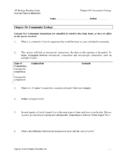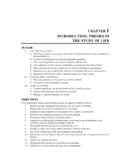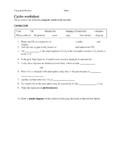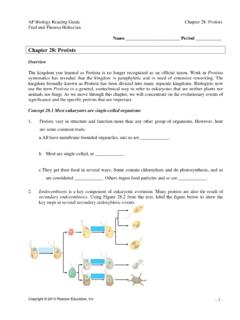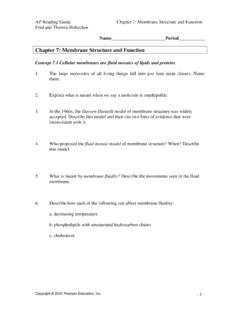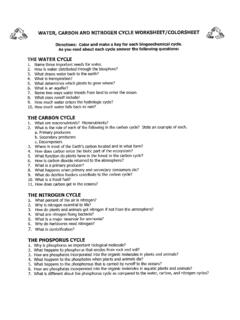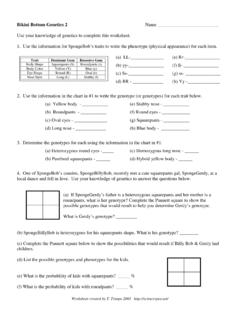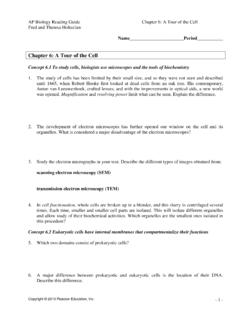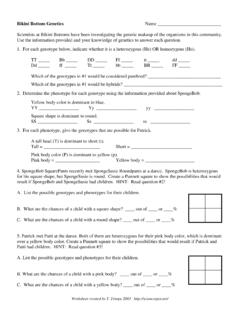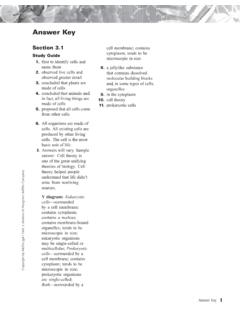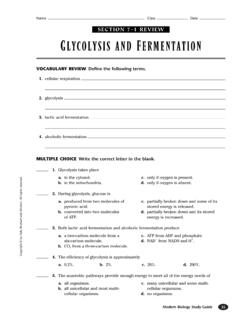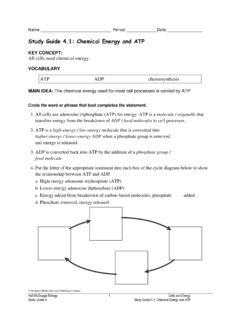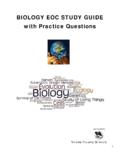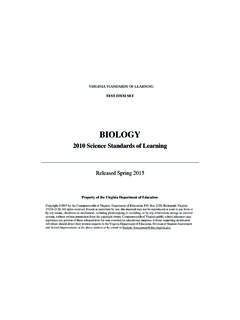Transcription of Chapter 6: A Tour of the Cell - Biology Junction
1 AP Biology Reading guide Chapter 6: a tour of the cell Fred and Theresa Holtzclaw Copyright 2010 Pearson Education, Inc. - 1 -Name_____Period_____ Chapter 6: a tour of the cell Concept To study cells , biologists use microscopes and the tools of biochemistry 1. The study of cells has been limited by their small size, and so they were not seen and described until 1665, when Robert Hooke first looked at dead cells from an oak tree. His contemporary, Anton van Leeuwenhoek, crafted lenses; and with the improvements in optical aids, a new world was opened. Magnification and resolving power limit what can be seen.
2 Explain the difference. 2. The development of electron microscopes has further opened our window on the cell and its organelles. What is considered a major disadvantage of the electron microscopes? 3. study the electron micrographs in your text. Describe the different types of images obtained from: scanning electron microscopy (SEM) transmission electron microscopy (TEM) 4. In cell fractionation, whole cells are broken up in a blender, and this slurry is centrifuged several times. Each time, smaller and smaller cell parts are isolated. This will isolate different organelles and allow study of their biochemical activities.
3 Which organelles are the smallest ones isolated in this procedure? Concept Eukaryotic cells have internal membranes that compartmentalize their functions 5. Which two domains consist of prokaryotic cells ? 6. A major difference between prokaryotic and eukaryotic cells is the location of their DNA. Describe this difference. AP Biology Reading guide Chapter 6: a tour of the cell Fred and Theresa Holtzclaw Copyright 2010 Pearson Education, Inc. - 2 - 7. On the sketch of a prokaryotic cell, label each of these features and give its function or description. cell wall plasma membrane bacterial chromosome nucleoid cytoplasm flagella 8.
4 Why are cells so small? Explain the relationship of surface area to volume. 9. Describe how many neurons and intestinal cells each have greatly increased surface area. Concept The eukaryotic cell s genetic instructions are housed in the nucleus and carried out by the ribosomes 10. In the figure below, label the nuclear envelope, nuclear pores, and pore complex. 11. Describe the nuclear envelope. How many layers is it? What connects the layers? AP Biology Reading guide Chapter 6: a tour of the cell Fred and Theresa Holtzclaw Copyright 2010 Pearson Education, Inc. - 3 - 12. What is the nuclear lamina?
5 Nuclear matrix? 13. Found within the nucleus are the chromosomes. They are made of chromatin. What are the two components of chromatin? When do the thin chromatin fibers condense to become distinct chromosomes? 14. When are the nucleoli visible? What are assembled here? 15. What is the function of ribosomes? What are their two components? 16. Ribosomes in any type of organism are all the same, but we distinguish between two types of ribosomes based on where they are found and the destination of the protein product made. Complete this chart to demonstrate this concept. Type of Ribosome Location Product Free ribosomes Bound ribosomes Concept The endomembrane system regulates protein traffic and performs metabolic functions in the cell 17.
6 List all the structures of the endomembrane system. AP Biology Reading guide Chapter 6: a tour of the cell Fred and Theresa Holtzclaw Copyright 2010 Pearson Education, Inc. - 4 - 18. The endoplasmic reticulum (ER) makes up more than half the total membrane system in many eukaryotic cells . Use this sketch to explain the lumen, transport vesicles, and the difference between smooth and rough ER. 19. List and describe three major functions of the smooth ER. 20. Why does alcohol abuse increase tolerance to other drugs such as barbiturates? 21. The rough ER is studded with ribosomes.
7 As proteins are synthesized, they are threaded into the lumen of the rough ER. Some of these proteins have carbohydrates attached to them in the ER to form glycoproteins. What does the ER then do with these secretory proteins? 22. Besides packaging secretory proteins into transport vesicles, what is another major function of the rough ER? AP Biology Reading guide Chapter 6: a tour of the cell Fred and Theresa Holtzclaw Copyright 2010 Pearson Education, Inc. - 5 - 23. The transport vesicles formed from the rough ER fuse with the Golgi apparatus. Use this sketch to label the cisterna of the Golgi apparatus, and its cis and trans faces.
8 Describe what happens to a transport vesicle and its contents when it arrives at the Golgi. 24. What is a lysosome? What do they contain? What is their pH? 25. One function of lysosomes is intracellular digestion of particles engulfed by phagocytosis. Describe this process of digestion. What human cells carry out phagocytosis? AP Biology Reading guide Chapter 6: a tour of the cell Fred and Theresa Holtzclaw Copyright 2010 Pearson Education, Inc. - 6 -26. A second function of lysosomes is to recycle cellular components in a process called autophagy. Describe this process. 27. What happens in Tay-Sachs disease?
9 Explain the role of the lysosomes in Tay-Sachs. 28. There are many types of vacuoles. Briefly describe: food vacuoles contractile vacuoles central vacuoles in plants (give at least three functions/materials stored here) 29. Use this figure to explain how the elements of the endomembrane system function together to secrete a protein and to digest a cellular component. Label as you explain. AP Biology Reading guide Chapter 6: a tour of the cell Fred and Theresa Holtzclaw Copyright 2010 Pearson Education, Inc. - 7 -Concept Mitochondria and chloroplasts change energy from one form to another 30.
10 Mitochondria and chloroplasts are not considered part of the endomembrane system, although they are enclosed by membranes. Sketch a mitochondrion here and label its outer membrane, inner membrane, inner membrane space, cristae, matrix, and ribosomes. 31. Now sketch a chloroplast and label its outer membrane, inner membrane, inner membrane space, thylakoids, granum, and stroma. Notice that the mitochondrion had two membrane compartments, while the chloroplast has three compartments. 32. What is the function of the mitochondria? 33. What is the function of the chloroplasts?
